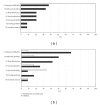Psychological profile in children and adolescents with severe course Juvenile Idiopathic Arthritis
- PMID: 22629213
- PMCID: PMC3354719
- DOI: 10.1100/2012/841375
Psychological profile in children and adolescents with severe course Juvenile Idiopathic Arthritis
Abstract
Objective: Juvenile Idiopathic Arthritis (JIA) is the most common chronic pediatric rheumatic disease. It is recognized that only reliance on clinical signs of disease outcome is inadequate for understanding the impact of illness and its treatment on child's life and functioning. There is a need for a multidisciplinary and holistic approach to children with arthritis which considers both physical and emotional functioning. This study investigated the psychosocial functioning of children and adolescent with JIA and the disease-related changes in their family.
Methods: The sample consisted of 33 hospitalized patients, aged 6-16 years. Both parents and the children were given a number of questionnaire to fill out. Clinical information was extracted from the interviews.
Results: Self-reported psychological functioning (depression, anxiety, and behavior) was not different from the normal population; however significant psychological suffering was detected by the clinical interview.
Conclusions: Children and adolescents with JIA do not show overt psychopathology by structured assessment; nevertheless a more clinically oriented holistic approach confirms JIA as a disrupting event causing relevant changes in the quality of life of the affected families.
Figures
Similar articles
-
Clinical and psychosocial stress factors are associated with decline in physical activity over time in children with juvenile idiopathic arthritis.Pediatr Rheumatol Online J. 2021 Jun 29;19(1):97. doi: 10.1186/s12969-021-00584-4. Pediatr Rheumatol Online J. 2021. PMID: 34187498 Free PMC article.
-
Body experiences, emotional competence, and psychosocial functioning in juvenile idiopathic arthritis.Rheumatol Int. 2013 Aug;33(8):2045-52. doi: 10.1007/s00296-013-2685-4. Epub 2013 Feb 8. Rheumatol Int. 2013. PMID: 23392772
-
Maternal stress associated with juvenile idiopathic arthritis.Int J Rheum Dis. 2014 Jun;17(5):541-7. doi: 10.1111/1756-185X.12394. Epub 2014 Jun 4. Int J Rheum Dis. 2014. PMID: 24894200
-
The clinical presentation in adulthood of juvenile idiopathic arthritis.Minerva Med. 2019 Oct;110(5):450-454. doi: 10.23736/S0026-4806.19.06095-6. Epub 2019 May 27. Minerva Med. 2019. PMID: 31142092 Review.
-
Assessment and management of pain in juvenile idiopathic arthritis.Pain Res Manag. 2012 Nov-Dec;17(6):391-6. doi: 10.1155/2012/237258. Pain Res Manag. 2012. PMID: 23248812 Free PMC article. Review.
Cited by
-
Depression And Anxiety In Patients With Juvenile Idiopathic Arthritis: Current Insights And Impact On Quality Of Life, A Systematic Review.Open Access Rheumatol. 2019 Nov 1;11:237-252. doi: 10.2147/OARRR.S174408. eCollection 2019. Open Access Rheumatol. 2019. PMID: 31807093 Free PMC article. Review.
-
'The current mental health status of children and young people with JIA, and their wider family': a charity partner collaboration survey.Pediatr Rheumatol Online J. 2023 Oct 6;21(1):111. doi: 10.1186/s12969-023-00898-5. Pediatr Rheumatol Online J. 2023. PMID: 37798784 Free PMC article.
-
Rationale, design and baseline data of a mixed methods study examining the clinical impact of a brief transition programme for young people with juvenile idiopathic arthritis: the DON'T RETARD project.BMJ Open. 2013 Dec 2;3(12):e003591. doi: 10.1136/bmjopen-2013-003591. BMJ Open. 2013. PMID: 24302502 Free PMC article.
-
Examination of Behavioral and Neuropsychological Characteristics of Hungarian Patients with Juvenile Idiopathic Arthritis: A Cross-Sectional Analysis.Children (Basel). 2025 Aug 12;12(8):1057. doi: 10.3390/children12081057. Children (Basel). 2025. PMID: 40868508 Free PMC article.
-
Behavioral Problems in Juvenile Idiopathic Arthritis: A Controlled Study to Examine the Risk of Psychopathology in a Chronic Pediatric Disorder.Int J Chronic Dis. 2016;2016:5726236. doi: 10.1155/2016/5726236. Epub 2016 Aug 30. Int J Chronic Dis. 2016. PMID: 27656678 Free PMC article.
References
-
- Falcini F, Cimaz R. Juvenile rheumatoid arthritis. Current Opinion in Rheumatology. 2000;12(5):415–419. - PubMed
-
- Barlow JH, Shaw KL, Harrison K. Consulting the ‘experts’: children’s and parents’ perceptions of psycho-educational interventions in the context of juvenile chronic arthritis. Health Education Research. 1999;14(5):597–610. - PubMed
-
- Rapoff MA, McGrath AM, Lindsley CB. Medical and psychological aspects of juvenile rheumatoid arthritis. In: Roberts MC, editor. Handbook of Pediatric Psychology. 3rd edition. New York, NY, USA: Guidford; 2003.
-
- Wallander JL, Varni JW, Babani L, Tweddle Banis H, Thompson Wilcox K. Family resources as resistance factors for psychological maladjustment in chronically ill and handicapped children. Journal of Pediatric Psychology. 1989;14(2):157–173. - PubMed
MeSH terms
LinkOut - more resources
Full Text Sources
Medical





